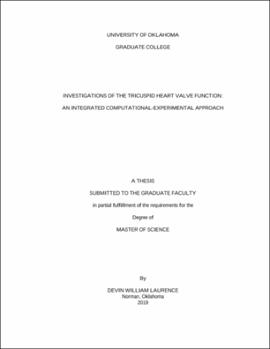| dc.description.abstract | The objective of this research is to employ both in silico modeling and in vitro experimental characterization methods to enhance the understanding of the biomechanical function of the tricuspid heart valve.
A finite element (FE)-based computational model of the tricuspid valve (TV) is first developed. Specifically, the geometry used in this computational model is based on parametric representations of the TV leaflets from porcine and ovine hearts and a parametric representation of the chordae tendineae. A nonlinear, isotropic constitutive model is used to describe of the mechanical behaviors of the TV leaflets, while the TV chordae tendineae are modeled as a nonlinear, elastic solid.
The developed FE model of the TV apparatus is then used to simulate various pathological states including: (i) pulmonary hypertension, (ii) TV annulus dilation, (iii) papillary muscle displacement associated with right ventricular enlargement, (iv) flattening of the TV annulus, and (v) the rupture of the TV chordae tendineae. Numerical results from this study, as compared to available clinical observations, suggest that the TV annulus dilation and papillary muscle displacement resulting from right ventricular enlargement are key contributors to TV regurgitation. On the other hand, pulmonary hypertension resulted in the largest increase in TV leaflet stress (+65%) indicating pulmonary hypertension may be a key contributor to the adverse remodeling of the leaflet and myocardium tissues. In addition, the simulations of the chordae rupture scenarios reveal that those chordae tendineae attached to the TV anterior and septal leaflets may be more important to preventing TV leaflet prolapse.
Extensive biaxial mechanical testing of the TV leaflets is conducted to expand on the limited number of mechanical characterizations of the TV leaflets. These experimental efforts include: (i) a quantification of the TV leaflets’ biaxial mechanical responses, (ii) an investigation of the loading-rate and temperature effects on the TV leaflet tissue mechanics, (iii) an examination of the influence of species and aging on the TV leaflet’s mechanical properties, (iv) an evaluation of the spatial variations of the TV leaflet’s tissue mechanics, and (v) a determination of the contribution of the glycosaminoglycans (GAGs) to the TV leaflet’s mechanical responses. These in vitro experimental results suggest that (i) the TV leaflets are more extensible than the mitral valve leaflets, (ii) the TV leaflets’ responses depend slightly on the loading rate and temperature, (iii) the mechanical responses of the TV leaflets become stiffer with aging (+3.5%-6.1%), (iv) the TV leaflets exhibit spatial variance in the mechanical properties, and (v) the removal of the GAGs leads to an increased extensibility of the TV leaflets (+4.7%-7.6%).
Finally, a constitutive modeling framework, based on the hyperelasticity theory, is formulated to describe the mechanical behaviors of the heart valve leaflets from the acquired biaxial mechanical data. Through the differential evolution optimization, model parameters of two strain energy density functions commonly adopted in the soft tissue biomechanics society are estimated by fitting to the representative biaxial mechanical testing data. Results from this numerical study suggest that a refined strain energy density function may be warranted, as part of the future extensions, to fully capture the complex mechanical responses of the heart valve leaflet, especially under combined tensile and compressive loading. | en_US |

